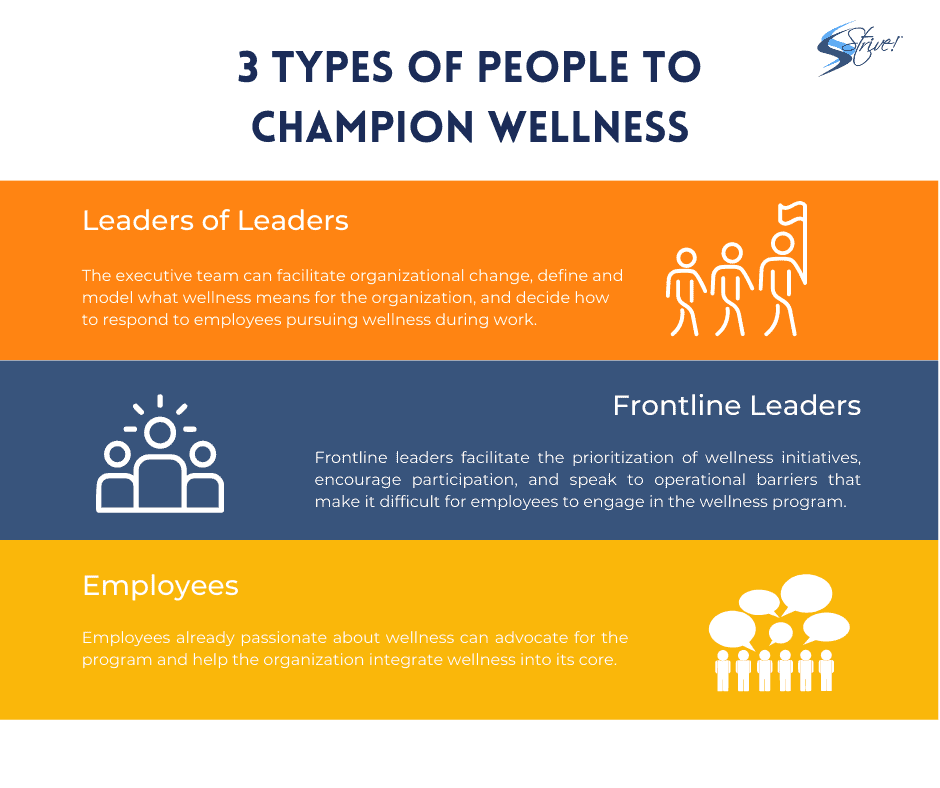Fitness & Wellness Workplace Trends 2025
The corporate wellness playbook has changed with the advent of hybrid and remote work models. Organizations are now incorporating virtual offerings within their wellness programs. However, the changes to the playbook are not so significant that they’ve changed the core principles of a successful wellness program implementation. A little experience and know-how of best practices will ensure operations can run smoothly.
Today we’ll share some of the wellness initiatives that are on the way out and the core principles that help employers create successful wellness programs. A successful wellness program should increase employee productivity, reduce presenteeism, assist talent acquisition, and increase employee retention. By framing the wellness program with an employee-centric mission, the organization can provide the best programming to its employees.
Modern Workplace Wellness Ideas
In this post:
1. Workplace Wellness Approaches on their Way Out
Workplace Wellness Trends on the Way Out
Because of the transition to hybrid and remote work models, two wellness initiatives are receiving less financial priority.
Biometric Screenings
Once a core piece of any corporate wellness program, biometric screenings are on the decline. The reasons are three-fold:
- Biometric screenings have little to no impact on changing employee health behaviors
- Biometric screenings are often associated with an employer-first wellness agenda that organizations are moving away from
- Biometric screenings are becoming logistically burdensome with hybrid and remote workforces
More importantly, there are alternative workplace wellness initiatives that can help employees create lasting behavior change while building the organization’s wellness culture.
Wellness Product & Service Reimbursement
While many organizations have opted for reimbursement programs in the past, they are reevaluating these programs today. Organizations are questioning the impact of these reimbursement programs on the overall well-being of their employees and are repurposing those resources to further optimize the wellness program.
Organizations that choose to continue offering a reimbursement program may decide to scale back the program and dedicate those resources to better wellness programming as a whole.
Successful Employee Well-Being Best Practices
When viewing these best practices, consider them as elements of a grand strategy for implementing a wellness program. This article will focus on the strategy, rather than initiatives. With the right strategy in place, the effectiveness of each initiative magnifies.
If an organization is interested in seeing cost containment and elevated cultural perception, it must consider the execution and delivery of each initiative.
Here are the most up-to-date best practices for wellness programs:
- Elicit Employee Feedback for Programming
- Integrate Wellness into the Culture
- Offer Weekly Programming
- Have an Ongoing Engagement Strategy
- Collect & Respond to Engagement Data
We wrote an article on the top wellness initiatives for 2023 that can satisfy multiple wellness initiatives. The article is also useful for organizations navigating a tight wellness budget that want to get the maximum benefit out of their program offerings.
Elicit Employee Feedback for Programming
Organizations that don’t yet possess a wellness program or are looking to revamp their programs should always begin by asking their employee population. There isn’t a cookie-cutter wellness program that every organization can incorporate.
By understanding individual employee needs, the organization can curate a program with the broadest scope of positive impact, ensuring the highest levels of company support and engagement.
The most successful wellness programs are built on employee-centric design principles.
This is not suggesting that organizations should forgo measuring their programs’ VOI (Value on Investment), but instead that they should anticipate better results when they design their programs based on collected employee feedback rather than assumption.
Start where there is demand and build the program up from there. Administer a needs & interest survey to determine what employees would be interested in. At a minimum, the survey should collect employee feedback on the following:
- Wellness topics employees are interested in learning about
- Types of classes and events (i.e. fitness, yoga, mindfulness/meditation, pilates, Zumba, health talks, cooking demos, etc.)
- What days are employees available to participate
- What times are they available to participate
- Yes/No – would the employee participate if the wellness services were available to them at no-cost
- Employee demographic details (department, location, etc.)
Integrate the Wellness Program into the Organization
When organizations attempt to staple their wellness programs onto an established company culture, the clunkiness is experienced by the employees. The wellness program can be perceived as an afterthought and not a concerted effort to bring wellness into the organization’s culture.
One of the ways an organization can build wellness into its culture is by finding individuals within the organization to champion the wellness program. These individuals can be:
- Leaders of leaders
- Frontline leaders
- Employees
In another post, we discussed how leadership communicating support for employer-sponsored wellness programs builds culture. When organizations view their wellness program as core to the business, they begin to make operational changes to facilitate employee wellness that nurtures the organization’s wellness culture.
Leaders of Leaders
The executive team is the heart of the organization. Without their support, the wellness program is unlikely to survive after its initial launch. Leadership teams can remove barriers for wellness initiatives, which is essential when there are multiple hurdles before approval.
Leaders have three ways they help integrate wellness into the organization:
- Facilitate necessary organizational changes for promoting workplace wellness
- Define what wellness means for the organization through their leading by example
- Decide how the organization responds to employees pursuing wellness during work
Leadership aligned with the organization’s wellness initiatives ensures the program is constantly building momentum.
Frontline Leaders
Even though having top leadership support is crucial for integrating the wellness program into the organization through processes and procedures, frontline leaders are paramount when encouraging employee adoption. Frontline leaders can facilitate the prioritization of wellness initiatives within their departments.
They ensure employees are made aware of the available wellness programming and have the closest connection with these employees to encourage them to participate. Supportive frontline leaders with direct interactions with employees become a powerful force for spreading wellness adoption throughout the organization.
Frontline leaders can also speak to the operational barriers that make it difficult for employees to participate in the wellness program. Organizations that want to see wellness permeate the organizational identity must leverage the knowledge and experience of their frontline leaders to eliminate mid-level and low-level operational barriers to adoption.
Discover 5 Ways for Middle Management to Champion Wellness.
Employees
Every employee has a different relationship with wellness. Identifying employees who are already passionate about wellness and turning those employees into wellness advocates helps the entire organization integrate wellness into its core. Employee wellness champions provide lateral encouragement for further adoption from other employees.
We wrote an article on optimizing workplace wellness engagement by looking at the four groups of employees that interact with the wellness program. By focusing on the needs of each group, organizations can optimize their engagement strategy.

Weekly Programming
Organizations that want to build wellness programs with long-term engagement should plan for weekly programming that employees can attend on a weekly basis.
The purpose of weekly programming is to build consistency that employees can use to start incorporating routine wellness habits into their lives. Ultimately, the wellness program aims to help employees create lifelong healthy habits.
It is better to have consistent and effective programming than to run the budget on “bursts” of wellness. Some organizations spend a significant amount of their wellness budget on planning a single large wellness fair.
While the event may be a huge success in terms of turnout, execution, knowledge dissemination, and even a much-needed morale boost, the event does not necessarily translate into long-term habits. The reliability of consistently scheduled programming supports employees in establishing or supplementing their wellness goals.
Have a Plan for Engaging Employees on an Ongoing Basis
An employee engagement strategy is part of a bigger initiative to successfully implement a wellness program. An ongoing engagement strategy captures current and newly engaged employees.
Engagement is not just participation. Engagement also includes asking employees to collaborate on developing the wellness program’s direction and investing their experience and insights into improving the program.
In marketing, we refer to these “customers” as raving fans. These employees repeatedly participate in the wellness activities, promote the programming to coworkers, and share their feedback to improve the wellness experience for everyone.
All wellness programs should strive for this level of engagement because it conveys deep employee buy-in for organizational wellness and the wellness program.
It is also important to capture negative feedback to improve the program. Don’t shy away from criticism. Negative feedback conveys employee belief in the effectiveness of the wellness program and the potential for a more significant organizational impact.
Collect Data & Make Improvements to the Program
Our ongoing effort to build a memorable wellness program experience is providing clients with monthly engagement data. Many organizations use participation data as an indicator of a wellness program’s impact on the workforce to drive positive change in the wellness program.
- Some examples of data and collection intervals include:
- Annual wellness program surveys
- Monthly attendance
By building recurring data collection and analysis as part of the wellness strategy, the wellness program can be agile and produce timely changes for sustainable momentum.
Implementing Wellness Strategies with Strive
Strive can provide around-the-clock classes, supporting workforce populations of 24-hour operations. Not only does Strive offer classes at all times, we also have a large variety of classes and events that organizations can offer their employees.
Organizations looking to go beyond inefficient, cookie-cutter programming look to Strive for wellness solutions that meet employee needs. Strive provides flexibility to clients with class variety, sourcing qualified instructors, and offering administrative support for their wellness programs.
Strive provides monthly summary reports and engagement data so organizations can evaluate the effectiveness of their wellness programming. A designated account manager works with our clients to grow their programs and implement timely changes efficiently. Our account managers are well-versed in the best practices, guiding our clients through decisions to optimize their wellness programs.



